ARTICLE AD BOX

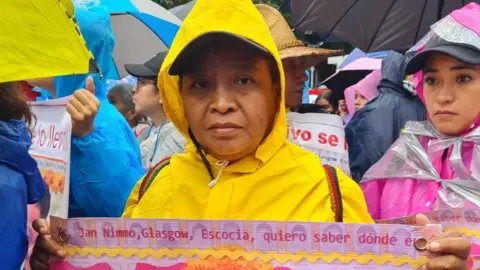 BBC
BBC
Luz María Telumbre is still seeking answers
Through driving rain, Luz Maria Telumbre travelled to Mexico City from the western state of Guerrero to mark 10 years since the darkest night of her life.
Her son, Cristian Alfonso, should be nearing his 30th birthday.
Instead, she’s carrying an image of him frozen in time – at just 19, when he and his classmates were abducted by Mexican police.
Christian was one of 43 student teachers travelling from the Ayotzinapa teacher training college, which has a strong history of activism, to an annual protest in Mexico City.
The students disappeared from the city of Iguala, and were last seen on security camera footage lying face-down on the back of police pick-up trucks as they were spirited out of the city.
The full story of the insidious relationship between the state and the cartels in Guerrero - and its part in the students’ abduction - has never been fully established.
In the intervening years, Luz Maria and the other victims’ parents have been calling for the same thing. “Alive they took them, alive we want them back,” they chant.
In essence, it’s a call for the authorities to clarify exactly what happened to their children that night on 26 September 2014, to admit full culpability and to prosecute those involved.

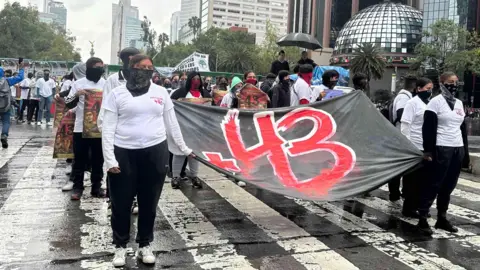
The protesters waved a banner commemorating the 43 missing student teachers
An initial investigation, under then-President Enrique Peña Nieto, concluded that corrupt municipal police from Iguala and surrounding towns, acting on orders from the local mayor, handed the students over to the Guerreros Unidos drug cartel.
According to the investigation, the cartel killed the students and disposed of their remains, while federal police and military were deemed to be uninvolved.
However, this version - labelled "the historic truth" - was met with widespread scepticism. The Inter-American Commission on Human Rights (IACHR) challenged the findings, calling them "scientifically impossible".
Further investigations have added new layers of complexity.
Journalist Anabel Hernández presented an alternative theory. She suggested that buses commandeered by the students to take them to Mexico City – a regular practice which was tolerated by the bus companies – were secretly transporting heroin.
Under her theory, the Mexican Army, acting on behalf of drug traffickers, intercepted the shipment, leading to the students' deaths to eliminate any witnesses.
As a presidential candidate, Andres Manuel Lopez Obrador made repeated promises to leave no stone unturned in the case of the 43, and as president, he established a "truth commission" to reopen the case – promising to follow the evidence wherever it led.
Around a dozen soldiers were subsequently arrested as well as the former Attorney General Jesus Murillo Karam. However, almost all of those detained have since been subsequently released.
Furthermore, the independent investigators abruptly withdrew from Mexico last year citing a raft of issues with state authorities including a “lack of information”, “secrecy” and “hidden evidence”.
In February, the families of the missing students announced they would cease contact with the commission due to frustrations over the military's lack of transparency.
Luz Maria firmly believes Lopez Obrador’s administration blocked the investigation as it began to close in on the military.
“Given how the investigation collapsed under Mr Lopez Obrador, he never gave us an answer,” she told the BBC as the march began to get underway.
“Things began to get tricky when we told him the Mexican army was responsible for the disappearance of our children and he didn’t want to investigate any further," she claims.
Luz Maria is concerned that the military now plays an outsized role in Mr Lopez Obrador’s administration, responsible for everything from the construction of government infrastructure projects to national security.
“The army are criminals dressed up in military,” is her brutal assessment.
As the march makes its way through the rain down Mexico City’s Reforma Avenue, groups of young indigenous student teachers chant defiantly, the rage evident in their voices.
They’re incensed that, a decade on, they are still demanding to know what happened to their friends, and fearful that the impunity of this case means it could easily be repeated in the future.
Earlier in the day at his morning press conference, President Andres Manuel Lopez Obrador insisted his outgoing government had done “everything (it) could to find the students”.
He has publicly called their disappearance a “state crime” and again assured the families his administration was “not protecting anyone”.
“We wanted to know everything”, he said. “But things got complicated and tangled because of different interests.”

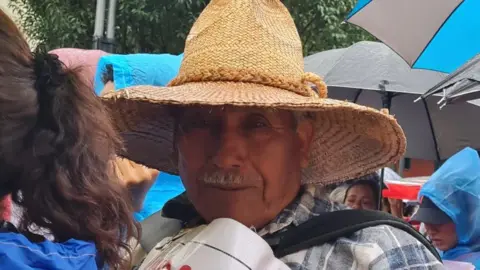
Margarito Guerrero no longer believes the government's assurances
As the protesters pause for a minute at a monument erected to the 43, Margarito Guerrero, the father of another kidnapped teenager, Jhosivani, says the president’s assurances no longer amount to much.
In fact, he believes officialdom in Mexico has deliberately placed obstacles in the relatives’ path to prevent them from reaching the truth.
“We feel like they’ve strung us along for years to try to tire us out. But we’re not tired”, he says with a hint of a smile. “And if they don’t give us an answer, we’ll keep going. For us, our children are still alive until we see some proof to the contrary.”
The drenched protesters – their feet wet but their resolve unbroken – reach their final destination, Mexico City’s main plaza, the Zócalo.
The victims’ parents, those most affected by the terrible events of a decade ago, walk onto a stage to address the crowd. Behind them, the National Palace, Mexico’s seat of power, is cordoned off by a ring of steel.
As fiery left-wing speakers deliver speeches about the 43’s place in a wider struggle between the indigenous poor and the Mexican state, the barricades represent more than just a fence.
They’re another kind of barrier between the Mexican Government, led by a president who promised to get to the bottom of what happened that night, and the families.
“One, 2, 3, 4” the parents count out loud, until they reach 43, a number now synonymous in Mexico with one of the worst human rights violations in its modern history.
“Alive they took them, alive we want them back," they shout once more into the rain-soaked night.

 3 months ago
20
3 months ago
20
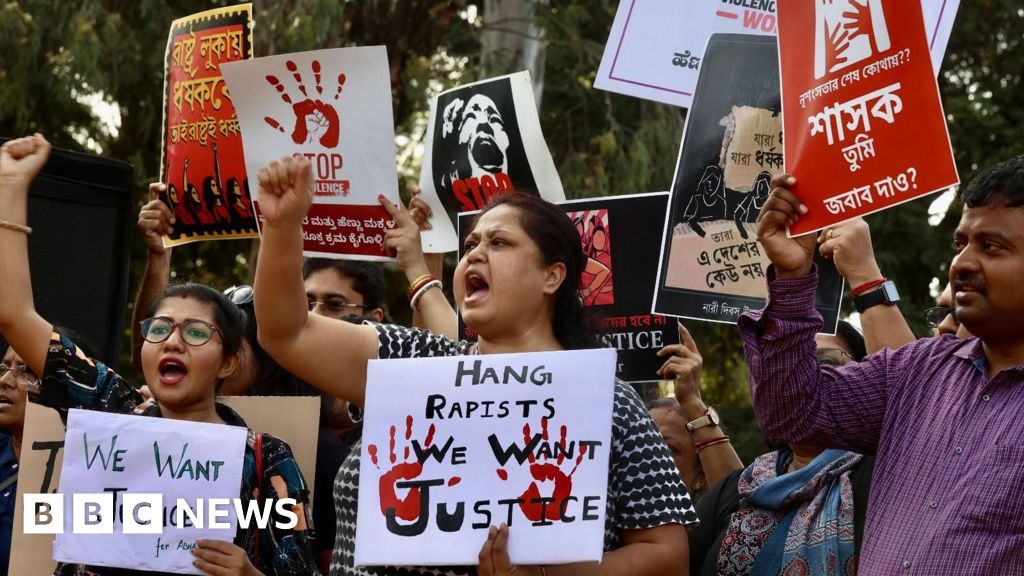
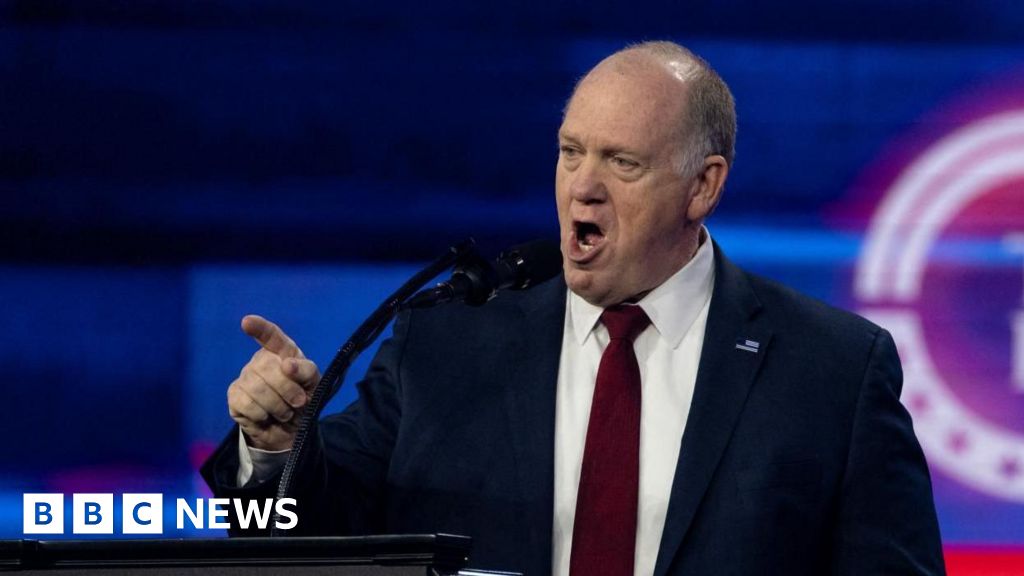
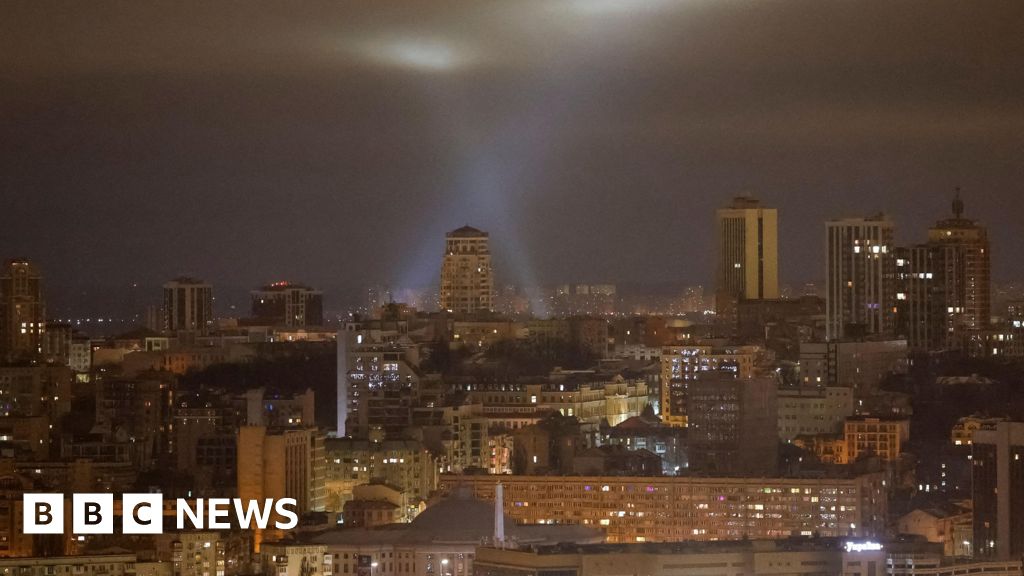





 English (US) ·
English (US) ·